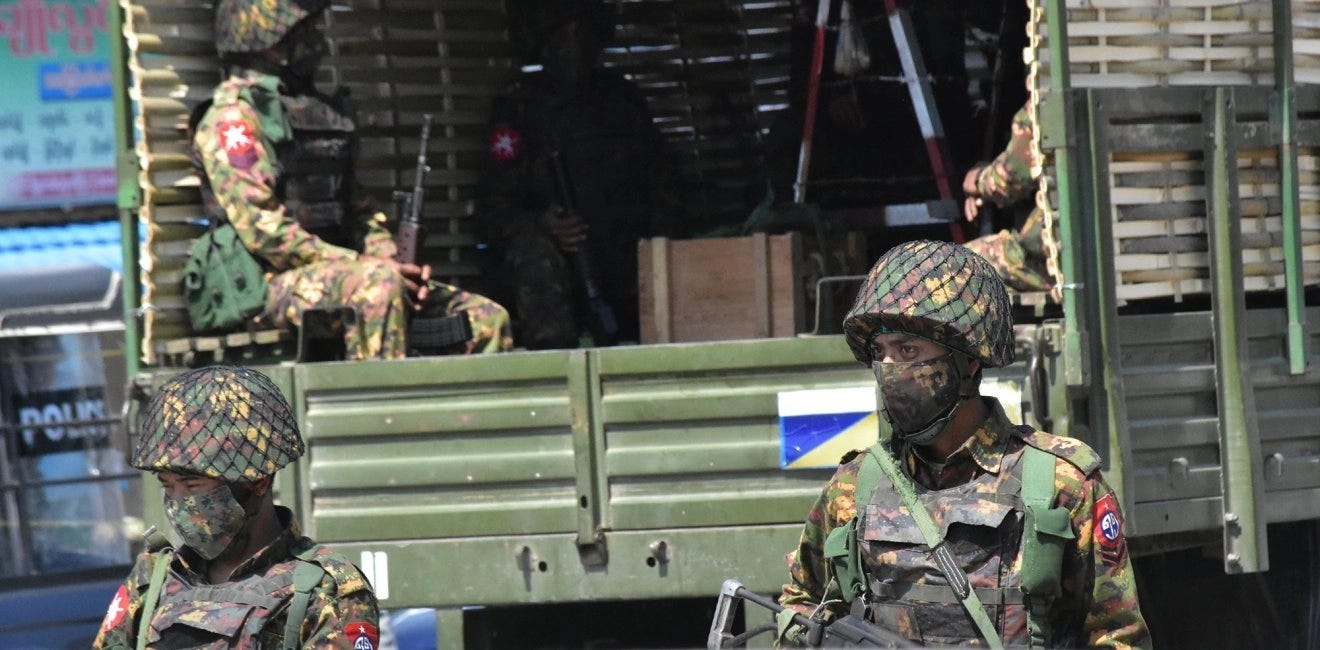Myanmar’s Junta Regains Ground Against Rebels
But tenacious resistance continues to hold on
By: David Scott Mathieson
Slowly but surely, Myanmar’s rebranded junta, the State Security and Peace Commission (SSPC), is grinding down the resistance forces in a multi-pronged offensive to take back territory lost to the rebels in their late 2023 drive, dubbed Operation 1027.
Bolstered by diplomatic and military aid by Beijing out of fear of a Syria-style meltdown on China’s border, military units of the Myanmar army, known as the Tatmadaw, have been replenished and have gone on the offensive against rebel People’s Defense Forces in multiple parts of Central Myanmar, in Mandalay and Sagaing especially. Despite indisputable setbacks in several battlefields, however, it’s premature to claim the armed resistance is losing.
The junta’s units in July scored their most dramatic reversal with the recapture of the Northern Shan State town of Naunghkio, occupied in mid-2024 by the Ta-ang National Liberation Army (TNLA) and their ethnic Kokang allies in the Myanmar National Democratic Alliance Army (MNDAA) and other smaller anti-regime forces. The MNDAA themselves had to relinquish the major city of Lashio to the junta back in April after pressure from Chinese authorities.
In recent weeks, the SSPC claims to have routed the Kachin Independence Army (KIA) from the strategically important town of Bhamo situated on the Irrawaddy River after nearly a year of fierce fighting. The military managed to keep troops resupplied and in recent months, reinforcements were flown in or travelled by ship to the embattled town.
The military’s own Myawady Daily reported on the Bhamo operation that there were “16 major battles and 490 clashes between December 4, 2024, and September 11, 2025. They seized 163 enemy corpses, 178 various weapons, and related equipment… the terrorist insurgent groups suffered approximately 4,616 deaths and around 4,983 injuries…as such, the dream of combined terrorist groups to fully occupy Bhamo had gone with the wind.”
The Kachin have also been losing ground in the jade mining area around Hpakant as more troops are deployed.
These aggressive renewed operations have displaced several thousand civilians. Unrelenting air strikes from jet fighters and helicopter gunships have aided the advances. One of the most notable setbacks is in Karenni State, where the armed resistance has lost key towns since Operation Yan Naing Min began in July, with Demoso town falling on August 19.
After nearly 18 months of fighting, the military’s Operation Aung Zeya has retaken control of the vital Asia Highway 1 between Hpa-an and the border town of Myawaddy, a considerable setback to the Karen National Liberation Army (KNLA). Yet the Karen army has also, during that period, overrun almost all SSPC bases along the Myanmar/Thailand border. On September 22, the military attacked the settlement of Lay Kay Kaw south of the border town of Myawaddy with a heavy artillery bombardment and hundreds of infantry troops. In Southern Myanmar, another offensive has started to retake control of Union Highway 8 between the Mon State capital of Mawlamyine to Dawei that has largely been controlled by a range of resistance forces for a couple of years.
The military is having little success in Rakhine State, however, where the Arakan Army (AA) continues to control almost the entire territory, with the capital Sittwe and the key port town of Kyaukphyu under siege for many months. The AA and its multiple PDF allies are also menacing the large numbers of crucial defense industry factors in Magwe and Bago. In the Eastern Bago region, the AA continues to hold up repeated Myanmar military advances, often inflicting heavy casualties.
How did an embattled regime that looked to be almost irreversibly diminished a year ago muster the resources and manpower to stage offensives on multiple fronts? The first is undeniably the success of the People’s Military Service Law in February 2024. The army has managed to conscript, much of it forcibly, train, equip, deploy, and make militarily effective more than 70,000 soldiers. The military recently started its 17th intake of soldiers for training. Crushing losses over the past four years have been replenished, regardless of doubts about quality or loyalty to the regime rendering them combat ineffective. The more ‘boots on the ground’ gambit is working, for now at least.
Another factor is China, which has made it clear with a flurry of high level visits that it supports the regime’s ‘transition’ plans for an election in December. Another factor is likely enhanced technology assistance from China over the past year, which has had a significant impact on augmented drone and anti-drone technology which proved particularly effective in the fighting in Naunghkio, for example.
In recent days, the SSPC Minister for Defence Maung Maung Aye visited Beijing where his delegation met with Chinese military technology companies and “observed unmanned aerial vehicle production, aviation technology equipment, electronic warfare systems, and air defense technology weapons.” Alongside Russian, Belarusian, Indian, and more than likely Israeli military assistance, the regime looks set to be well supplied.
The resistance is far from vanquished, however, despite indisputable setbacks. It is also a misnomer to claim the conflict is at a stalemate. It is still far too dynamic and unpredictable. Claiming the resistance is finished is just as irresponsible as breathless predictions of full regime collapse after Operation 1027. The armed groups’ gains, and now losses, need to be analyzed in a longer time frame than just reading daily headlines.
Caution must also be exercised in claiming the offensives that are all tied to planned elections in December. There are undeniably poll-related dynamics. But the civil war has its own complex logic and priorities. Retaking territory after two years of humiliating losses of bases and mass casualties is one important driver of the recent months of an entrenched regime striking back.
David Scott Mathieson is an independent analyst working on conflict, humanitarian, and human rights issues in Myanmar

